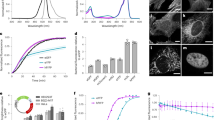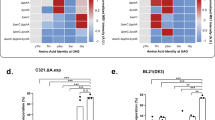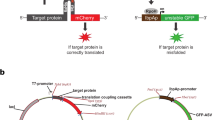Abstract
A recently developed method makes it possible to genetically encode unnatural amino acids with diverse physical, chemical or biological properties in Escherichia coli1 and yeast2. We now show that this technology can be used to efficiently and site-specifically incorporate p-iodo-L-phenylalanine (iodoPhe) into proteins in response to an amber TAG codon. The selective introduction of the anomalously scattering iodine atom into proteins should facilitate single-wavelength anomalous dispersion3,4 experiments on in-house X-ray sources. To illustrate this, we generated a Phe153 → iodoPhe mutant of bacteriophage T4 lysozyme and determined its crystal structure using considerably less data than are needed for the equivalent experiment with cysteine and methionine. The iodoPhe residue, although present in the hydrophobic core of the protein, did not perturb the protein structure in any meaningful way. The ability to selectively introduce this and other heavy atom–containing amino acids into proteins should facilitate the structural study of proteins.
This is a preview of subscription content, access via your institution
Access options
Subscribe to this journal
Receive 12 print issues and online access
$209.00 per year
only $17.42 per issue
Buy this article
- Purchase on Springer Link
- Instant access to full article PDF
Prices may be subject to local taxes which are calculated during checkout



Similar content being viewed by others
References
Wang, L., Brock, A., Herberich, B. & Schultz, P.G. Expanding the genetic code of Escherichia coli. Science 292, 498–500 (2001).
Chin, J.W. et al. An expanded eukaryotic genetic code. Science 301, 964–967 (2003).
Hendrickson, W. & Teeter, M. Structure of the hydrophobic protein crambin determined directly from the anomalous scattering of sulfur. Nature 290, 107–113 (1981).
Debreczeni, J.E., Bunkoczi, G., Ma, Q., Blaser, H. & Sheldrick, G.M. In-house measurement of the sulfur anomalous signal and its use for phasing. Acta Crystallogr. D Biol. Crystallogr. 59, 688–696 (2003).
Dauter, Z., Dauter, M. & Dodson, E. Jolly SAD. Acta Crystallogr. D Biol. Crystallogr. 58, 494–506 (2002).
Dauter, Z., Dauter, M., de La Fortelle, E., Bricogne, G. & Sheldrick, G.M. Can anomalous signal of sulfur become a tool for solving protein crystal structures? J. Mol. Biol. 289, 83–92 (1999).
Dauter, Z., Dauter, M. & Rajashankar, K.R. Novel approach to phasing proteins: derivatization by short cryo-soaking with halides. Acta Crystallogr. D Biol. Crystallogr. 56, 232–237 (2000).
Nagem, R.A., Dauter, Z. & Polikarpov, I. Protein crystal structure solution by fast incorporation of negatively and positively charged anomalous scatterers. Acta Crystallogr. D Biol. Crystallogr. 57, 996–1002 (2001).
Boles, J.O. et al. Bio-incorporation of telluromethionine into buried residues of dihydrofolate reductase. Nat. Struct. Biol. 1, 283–284 (1994).
Budisa, N. et al. Bioincorporation of telluromethionine into proteins: a promising new approach for X-ray structure analysis of proteins. J. Mol. Biol. 270, 616–623 (1997).
Brick, P., Bhat, T.N. & Blow, D.M. Structure of tyrosyl-tRNA synthetase refined at 2.3 Å resolution. Interaction of the enzyme with the tyrosyl adenylate intermediate. J. Mol. Biol. 208, 83–98 (1989).
Wang, L., Zhang, Z., Brock, A. & Schultz, P.G. Addition of the keto functional group to the genetic code of Escherichia coli. Proc. Natl. Acad. Sci. USA 100, 56–61 (2003).
Kirshenbaum, K., Carrico, I.S. & Tirrell, D.A. Biosynthesis of proteins incorporating a versatile set of phenylalanine analogues. Chembiochem 3, 235–237 (2002).
Eriksson, A.E., Baase, W.A. & Matthews, B.W. Similar hydrophobic replacements of Leu99 and Phe153 within the core of T4 lysozyme have different structural and thermodynamic consequences. J. Mol. Biol. 229, 747–769 (1993).
Nicholson, H., Anderson, D.E., Dao-pin, S. & Matthews, B.W. Analysis of the interaction between charged side chains and the alpha-helix dipole using designed thermostable mutants of phage T4 lysozyme. Biochemistry 30, 9816–9828 (1991).
Terwilliger, T.C. & Berendzen, J. Automated MAD and MIR structure solution. Acta Crystallogr. D Biol. Crystallogr. 55, 849–861 (1999).
Terwilliger, T.C. Maximum-likelihood density modification using pattern recognition of structural motifs. Acta Crystallogr. D Biol. Crystallogr. 57, 1755–1762 (2001).
Weaver, L.H. & Matthews, B.W. Structure of bacteriophage T4 lysozyme refined at 1.7 Å resolution. J. Mol. Biol. 193, 189–199 (1987).
Sakamoto, K. et al. Site-specific incorporation of an unnatural amino acid into proteins in mammalian cells. Nucleic Acids Res. 30, 4692–4699 (2002).
Otwinowski, Z. & Minor, W. Processing of X-ray diffraction data collected in oscillation mode. Methods Enzymol. 276, 307–326 (1997).
Collaborative Computational Project. N The CCP4 suite: programs for protein crystallography. Acta Crystallogr. D Biol. Crystallogr. 50, 760–763 (1994).
Schneider, T.R. & Sheldrick, G.M. Substructure solution with SHELXD. Acta Crystallogr. D Biol. Crystallogr. 58, 1772–1779 (2002).
Murshudov, G.N., Vagin, A.A. & Dodson, E.J. Refinement of macromolecular structures by the maximum-likelihood method. Acta Crystallogr. D Biol. Crystallogr. 53, 240–255 (1997).
van Aalten, D.M. et al. PRODRG, a program for generating molecular topologies and unique molecular descriptors from coordinates of small molecules. J. Comput. Aided Mol. Des. 10, 255–262 (1996).
Jones, T.A., Zou, J.Y., Cowan, S.W. & Kjeldgaard, M. Improved methods for building protein models in electron density maps and the location of errors in these models. Acta Crystallogr. A 47, 110–119 (1991).
Lamzin, V.S. & Wilson, K.S. Automated refinement of protein models. Acta Crystallogr. D Biol. Crystallogr. 49, 129–147 (1993).
Kraulis, P.J. MOLSCRIPT: a program to produce both detailed and schematic plots of protein structures. J. Appl. Crystallogr. 24, 946–950 (1991).
Merritt, E.A. & Murphy, M.E.P. Raster3D Version 2.0. A program for photorealistic molecular graphics. Acta Crystallogr. D Biol. Crystallogr. 50, 869–873 (1994).
Esnouf, R.M. An extensively modified version of MolScript that includes greatly enhanced coloring capabilities. J. Mol. Graph. Model. 15, 132–134 (1997).
Acknowledgements
We would like to thank Heidi Erlandsen and Raymond Stevens for technical assistance. J.X. thanks Jeremy Mills, Jun Yin and Yan Zhang for helpful discussions. This work is supported by a grant from the National Institutes of Health (GM62159) and the Skaggs Institute for Chemical Biology. This is manuscript number 16547-CH of the Scripps Research Institute.
Author information
Authors and Affiliations
Corresponding authors
Ethics declarations
Competing interests
The authors declare no competing financial interests.
Rights and permissions
About this article
Cite this article
Xie, J., Wang, L., Wu, N. et al. The site-specific incorporation of p-iodo-L-phenylalanine into proteins for structure determination. Nat Biotechnol 22, 1297–1301 (2004). https://doi.org/10.1038/nbt1013
Received:
Accepted:
Published:
Issue Date:
DOI: https://doi.org/10.1038/nbt1013
This article is cited by
-
Rapid discovery and evolution of orthogonal aminoacyl-tRNA synthetase–tRNA pairs
Nature Biotechnology (2020)
-
Continuous directed evolution of aminoacyl-tRNA synthetases
Nature Chemical Biology (2017)
-
Designer proteins: applications of genetic code expansion in cell biology
Nature Reviews Molecular Cell Biology (2012)
-
Biochemical analysis with the expanded genetic lexicon
Analytical and Bioanalytical Chemistry (2012)
-
Site-specific labeling of proteins with NMR-active unnatural amino acids
Journal of Biomolecular NMR (2010)



